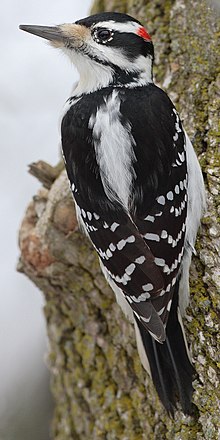Hairy woodpecker
| Hairy woodpecker | |
|---|---|
 |
|
| Male, eastern variant septentrionalis | |
| Scientific classification | |
| Kingdom: | Animalia |
| Phylum: | Chordata |
| Class: | Aves |
| Order: | Piciformes |
| Family: | Picidae |
| Genus: | Leuconotopicus |
| Species: | L. villosus |
| Binomial name | |
|
Leuconotopicus villosus (Linnaeus, 1766) |
|
| Synonyms | |
|
|
The hairy woodpecker (Leuconotopicus villosus) is a medium-sized woodpecker, averaging approximately 250 mm (9.8 in) in length with a 380 mm (15 in) wingspan. With an estimated population in 2003 of over nine million individuals, the hairy woodpecker is listed by the IUCN as a species of least concern in North America. Some taxonomic authorities, including the American Ornithological Society, continue to place this species in the genus Picoides.
The hairy woodpecker inhabits mature deciduous forests in the Bahamas, Canada, Costa Rica, El Salvador, Guatemala, Honduras, Mexico, Nicaragua, Panama, Puerto Rico, Saint Pierre and Miquelon, Turks and Caicos Islands, and the United States. Mating pairs will excavate a hole in a tree, where they will tend to, on average, lay four white eggs.
Adults are mainly black on the upper parts and wings, with a white or pale back and white spotting on the wings; the throat and belly vary from white to sooty brown, depending on subspecies. There is a white bar above and one below the eye. They have a black tail with white outer feathers. Adult males have a red patch or two side-by-side patches on the back of the head; juvenile males have red or rarely orange-red on the crown.
The hairy woodpecker measures from 18–26 cm (7.1–10.2 in) in length, 33–43 cm (13–17 in) in wingspan and 40–95 g (1.4–3.4 oz) in weight. It is virtually identical in plumage to the smaller downy woodpecker. The Downy has a shorter bill relative to the size of its head which is, other than size and voice, the best way to distinguish them in the field. One may identify the woodpecker by pik-call, counting one second between piks(a total of four must be heard). The rattle-call is short burst of the same sound, while DOWO resembles a bouncing ball.The drum sound might be used to identify the bird. It sounds similar to five taps. These two species are not closely related, however, and are likely to be separated in different genera. The best way to tell the two species apart other than the size is the lack of spots on its white tail feathers (which the Downy has). Their outward similarity is a spectacular example of convergent evolution. As to why this convergence has evolved, only tentative hypotheses have been advanced; in any case due to the considerable size difference, ecological competition between the two species is rather slight.
...
Wikipedia

